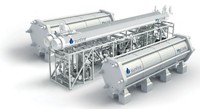Advertisement
Grab your lab coat. Let's get started
Welcome!
Welcome!
Create an account below to get 6 C&EN articles per month, receive newsletters and more - all free.
It seems this is your first time logging in online. Please enter the following information to continue.
As an ACS member you automatically get access to this site. All we need is few more details to create your reading experience.
Not you? Sign in with a different account.
Not you? Sign in with a different account.
ERROR 1
ERROR 1
ERROR 2
ERROR 2
ERROR 2
ERROR 2
ERROR 2
Password and Confirm password must match.
If you have an ACS member number, please enter it here so we can link this account to your membership. (optional)
ERROR 2
ACS values your privacy. By submitting your information, you are gaining access to C&EN and subscribing to our weekly newsletter. We use the information you provide to make your reading experience better, and we will never sell your data to third party members.
Business
Europe readies its bioeconomy
As the mood in the U.S. darkens, the biomaterials industry in Europe is optimistic
by Alex Scott
October 30, 2017
| A version of this story appeared in
Volume 95, Issue 43

For a decade, European biomaterial innovators have looked enviously across the Atlantic at the generous subsidies and eager venture capitalists that bankrolled the rapid growth of the U.S. bioeconomy.
But industrialists and academics who met recently in Brussels at the European Forum for Industrial Biotechnology (EFIB), the premier event for European biomaterials firms, are starting to see the world differently. The commercialization of novel bioprocesses in Europe is accelerating, financing for projects is more readily available, and government support is strengthening, they said.
Still, while enthusiasm at the 10th annual EFIB meeting largely reflected progress made, speakers also warned of problems ahead, including agricultural feedstock shortages and continued competition from low-cost fossil fuels.
“We’re at a turning point. We are going from aspiration to realization,” said John Bell, bioeconomy director for the European Commission, the executive arm of the European Union. The EU plans to introduce a series of initiatives to promote private investment in industrial biotechnology by reducing financial risk, Bell said.
As part of its strategy, the EU will direct a greater share of its science funding to biomaterials research, via programs such as its multi-billion-dollar Horizon 2020 research and technology development effort, said Daniel Calleja Crespo, the European Commission’s director general for the environment. He acknowledged that EU biomaterials legislation can be cumbersome but assured EFIB delegates that streamlined legislation promoting the bioeconomy is on its way. The planned rollout in the next few years of legislation promoting a circular economy—one that minimizes waste and encourages reuse—will further develop the bioindustry, Calleja Crespo said.
The good feeling at EFIB was boosted by the participation of a number of high-profile speakers, including soccer player Mathieu Flamini, who is a cofounder of the Italian levulinic acid producer GFBiochemicals.
In Flamini, Europe’s bioindustry may have found a figurehead. He told delegates he is willing to use his popularity to promote the sector and broaden understanding of industrial biochemistry’s role. “Perhaps I can encourage the kids to go into the bioeconomy,” he said.
Meanwhile, under President Donald J. Trump, U.S. policies relating to the biomaterials sector appear to be losing momentum. And though most of the U.S. biomaterials infrastructure has been set up around using corn to make ethanol and other chemicals, many Europeans are convinced that Europe’s predominant strategy of deriving biomaterials from raw materials that don’t have food uses is the route to long-term success.
A major challenge—especially for European companies—has been raising funds to scale up technologies, Tom van Aken, chief executive officer of the Dutch biomaterials firm Avantium, told delegates. Avantium was unable to clear the financial hurdles for commercializing its 2,5-furandicarboxylic acid (FDCA) and polyethylene furanoate processes on its own, so it partnered with BASF to create the joint-venture company Synvina (see page 17).
But even with the German giant as its partner, Avantium needed more capital to cofund a 50,000-metric-ton-per-year FDCA plant. And so in April, the firm raised almost $130 million in an initial public offering of its shares. “This is a very capital-intensive game,” van Aken said.
To help address the money issue, the European Commission plans to cofund a series of biorefineries across Europe that would enable pilot testing of developmental processes and integrate all actors in the value chain. “This is very important if we are to keep investment here in Europe,” said Philippe Mengal, executive director of Bio-based Industries (BBI), a public-private partnership between the EU and the Bio-based Industries Consortium, an industry body.
BBI has $4.3 billion available for projects from 2014 to 2020, of which 75% comes from industry and the rest from the European Commission. Now halfway through the program, BBI intends to put some of the remaining money toward the construction of three biorefineries, Mengal said, likely in Germany or Belgium. By 2030, plant material processed by biorefineries could replace 30% of chemicals derived from fossil fuels, Mengal claimed.
Such an approach could help pull multiple technologies toward the marketplace together, delegates enthused.
“Lots of small companies working alone will not survive. I believe this is where the EU can play really well,” said Tjerk de Ruiter, CEO of lactic acid producer Corbion. “In the past three or four years, we have overtaken the U.S. Now we have momentum. The difficult part is the large integrated biorefinery.” He called on the European Commission to help realize this plan.
The European Chemical Industry Council (Cefic), Europe’s main chemical industry organization, is hoping that a network of biorefineries will provide European chemical companies with a long-term option to compete against fossil-fuel feedstocks. “What we need in the EU is a shale gas of our own,” said Marco Mensink, director general of Cefic, referring to the shale gas feedstock cost advantage currently enjoyed by U.S. chemical firms.
But replacing petrochemical crackers with biorefineries will be neither quick nor straightforward, cautioned Pierre-Alain Schieb, president of the consulting firm Backcasting.
Replacing just one-third of Europe’s petrochemical production with biomaterials would require about 400 large biorefineries, he said. And the price tag could approach $230 billion. Schieb predicted that low-cost fossil-fuel imports to Europe will hamper the financing of these biorefineries. “Cheap imports of shale gas could have a very big effect,” he said.
Obtaining large amounts of biofeedstock is another challenge that Europe faces, Mensink said. Waste residues from Europe’s forestry sector can provide some of the raw material the bioindustry will need, he said, but other sources will be required.
Raw material sourcing and other issues notwithstanding, representatives from major European consumer goods companies including Ikea, Lego, L’Oréal, Michelin, and Renault declared at EFIB that they are eager to roll out more products made from biomaterials.
Demand for sustainable products among European consumers is building, they said. Michelin and L’Oréal—among others—are working together in BioSpeed, a consortium that aims to accelerate the commercialization of biomaterials.
The presence of representatives from large brand owners was heartening to bioindustry officials at the conference. Although biomaterials have yet to supplant a significant chunk of the petrochemicals industry, the marketplace wants it to happen, Avantium’s van Aken said.




Join the conversation
Contact the reporter
Submit a Letter to the Editor for publication
Engage with us on Twitter